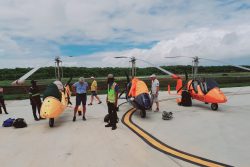Construction of the Amaila Falls Hydroelectric plant is likely to require an average workforce of approximately 700 persons and a peak of about 1,200 workers, but only about 40 per cent of these workers are likely to be Guyanese, the recently released Environmental and Social Impact Assessment (ESIA) says.
“Approximately 40% or more of the workforce may be semi-skilled and unskilled labourers who may be hired from within Guyana,” the ESIA says. According to the document, a significant portion of the necessary workforce will be technical and professional staff required for design and management of the construction operations and many of these workers may be Chinese. China Railway First Group Ltd would most likely build the plant. This company would also be responsible for retaining staff.
According to the ESIA, the engineering and construction contractor estimated an average workforce of about 700 workers and a peak of approximately 1,200 workers for the hydropower plant. Further, the workforce to construct the electrical interconnection is expected to average about 450 workers, reaching a maximum of about 650. The general labour types required include equipment and plant operators, mechanics, surveyors, truck drivers, foremen, electricians, carpenters, concrete masons, ironworkers, skilled and common labourers.
The ESIA also says that the project may cause tension between out-of-region construction and the local population. “Since most of the employed workers, whether immigrant or local, will be lodged at project construction camps, with the principal one at the hydropower facility, the project will not create a significant direct demand for housing or urban infrastructure in any nearby communities or cities.
However, indirect demand from project suppliers and from any induced population influx [may] affect living conditions of the existing nearby communities and cause social conflictions,” the document states. It added that “project workers and service providers may contribute to the spread of communicable diseases including sexually transmitted diseases, which may contribute to negative attitudes toward outsiders working for the project, even when they are from other parts of Guyana.”
According to the ESIA, “For workers coming from other countries, with cultural and language differences, this potential impact could be more severe.”
While stating that the presence of foreign workers of Chinese origin may aggravate social tensions, it is stated that “this risk will be reduced significantly through provisions in the labour force work contracts. All workers involved in construction, including subcontractor personnel, will receive initial training where workers will be instructed on the proper code of conduct toward other workers and the local population.”
Due to the new access road, the document says that there is a risk of illegal mining and forestry activities. “The primary potential area for illegal forestry activities would be from Kaburi to the hydropower site in currently unallocated forests.” The extent of any such impact would be determined by the capacity of the Guyana Forestry Commission (GFC) “to control illegal forestry and the effectiveness of controls placed on the Access Road west of Kaburi.”
Mining activity, the document says, “is highly dependent on access but also the commodity price and the perceived potential for finding the desired mineral resource in an area.” There is very little reported small-scale mining activity taking place in the hydropower site area or near the transmission line corridor.
Meanwhile, the ESIA says that some persons may be displaced as a result of the transmission corridor between Linden and Georgetown. “The transmission corridor between Linden and George-town is primarily state land with some leases held by private individuals for agricultural and other uses. Near Georgetown, the transmission line will use an existing GPL utility ROW (Right of Way) and in the final few kilometres in Georgetown, the existing transmission line ROW passes through some residential areas,” it notes.
During the field studies, about 17 residential dwellings were identified in the easement of the existing GPL transmission line in George-town. “It was also observed that local residents use the easement for small-scale subsistence activities, such as small-scale gardening and raising domesticated animals. Some physical resettlement or compensation for economic displacement may be required in these areas where squatters have encroached on the GPL ROW,” the ESIA says.
The ESIA, which was prepared by Exponent, Inc with support from Brazilian environmental consulting firm JGP Consultoria e Parici-pacoes Ltda, was officially released on Monday by Sithe Global LLC, the developer for the Amaila Falls project. A period of consultations is expected to commence shortly.
This ESIA is seen as key in securing funding for the project which is expected to commence later this year.









